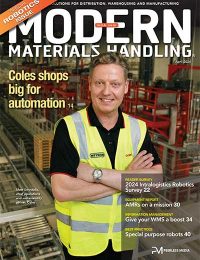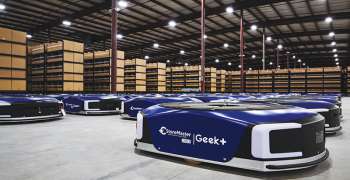Supply Chain and Logistics Technology: Multi-faceted LMS benefits await
Implementation complexities have stood in the way of LMS adoption rates; however, our analysts say that more logistics operations will focus attention on workforce management to balance efficiencies now that the business climate is on the upswing.
Latest Material Handling News
Logistics professionals have learned a thing or two during the most recent recession. As a whole, most learned how to work smarter, better, and faster with fewer resources. Technology played a key role in attaining some of the efficiencies, as did sharp eyes on bottom lines, expenditures, and waste.
However, with payroll costs eating up a large portion of any firm’s annual budget, labor management systems (LMS) will be one of several supply chain software sectors that logistics managers may look at more closely in 2012. In many cases, these systems are integrated into enterprise-wide solutions, but sometimes they’re purchased separately and implemented across one or more key departments.
Over the next few pages we’ll look at the state of LMS systems, reveal the key market drivers for this supply chain software segment, and then look closely at how one shipper is using a multi-faceted LMS to do more with less.
Managing labor
LMS manages and tracks the labor activities for distribution-based operations and typically incorporates real-time interaction with warehouse systems. Primarily deployed within the warehouse’s four walls, an LMS reports on labor activity and compares that activity against established labor standards and the company’s internal, historical data.
Due to the multi-faceted applications, Clint Reiser, a research analyst at ARC Advisory Group, expects the LMS market segment to experience a higher growth rate than the warehouse management systems (WMS) market as a whole this year. “Many suppliers informed us that they view LMS as a product/market segment that presents good growth opportunities,” Reiser adds. “Multiple suppliers also mentioned LMS as an area in which they plan to invest product development resources to expand functionality.”
A mature market by supply chain software standards, the LMS sector’s market penetration currently stands at 45 percent (compared to 80 percent for WMS), according to Dwight Klappich, research vice president for Gartner. He says that 23 percent of logistics professionals surveyed currently have a “fully deployed” LMS and 22 percent have “partially deployed” systems. Another 10 percent of shippers say they are currently exploring their LMS options.
“The numbers aren’t too bad, but I wouldn’t tell anyone to go out and start up an LMS business right now,” says Klappich.
“That company gets the biggest bang for its LMS buck,” Klappich explains. “A logistics operation with fewer than 100 employees didn’t typically invest the time, effort, and money in an LMS.” But that’s changing as technology is becoming more affordable and as more lower-cost solutions are being introduced to the marketplace.
Barriers to adoption
Installation and implementation complexities have stood in the way of LMS adoption rates. And while the systems themselves aren’t complex, says Klappich, capturing the necessary labor standards and accurate data at the outset is laborious.
Maintaining those standards over time—adding new employees, removing retired workers, and adapting to process changes within the company itself—requires a long-term commitment. “Unlike WMS, LMS isn’t a one-time investment and setup,” says Klappich. “If the system isn’t kept up to snuff, the data won’t be very good, the employee tracking will be inaccurate, and the whole system will deteriorate.”
Steve Banker, ARC’s service director for supply chain management, says LMS has remained “relatively stable” but hasn’t been a fast-growing market over the last few years. He says shippers’ apparent lack of interest in LMS is puzzling, based on the return on investment (ROI) that such systems typically produce.
“If you combine LMS with engineered labor standards, or getting the right people into the right jobs, and working at a consistent pace throughout the day, the ROI can be terrific,” Banker explains.
Another barrier to adoption can be the fact that companies assume that they need to have huge DCs in place before an LMS makes sense. Banker says vendors have picked up on this perception and are taking steps to garner a wider audience for their systems.
“Vendors have been introducing lower-cost solutions that integrate directly with WMS,” says Banker. “I’ve seen warehouses with as few as 25 employees get a good ROI from their LMS.”
Banker says helping shippers more effectively manage labor scheduling on a short-term (helping warehouse management schedule the right number of workers to handle the day’s workload) and long-term (for year-end budgeting exercises) basis will be the next logical step for LMS vendors.
“Warehouse managers that have historical labor costs and demand forecast data at their fingertips will be able to do much more accurate budgeting for the coming year,” says Banker.
The third-party logistics (3PL) industry is a likely “growth spot” for LMS in 2012, according to Banker, who sees the software as an efficient tracking and reporting mechanism for 3PLs.
“All 3PLs should be using LMS in combination with good engineering standards,” says Banker. “That allows shippers to track continuous improvements and operational efficiencies and ensures that the 3PL isn’t just passing on costs without worrying about how much labor was involved.”
LMS gains ahead
According to Klappich, WMS vendors missed the boat early on when it came to offering solid LMS to their users. As a result, he says that most LMS purchases were made “completely independently of WMS.”
That landscape has changed in recent years, as WMS vendors like Manhattan Associates and Red Prairie have stepped up to the plate and bundled LMS into their supply chain packages. Concurrently, best-of-breed vendors like Kronos continued to hone their independent LMS offerings, giving shippers additional automation choices for their labor management operations.
On average, Klappich says shippers using LMS can expect 5 percent to 10 percent labor productivity gains. He cautions, however, that the gains come not from the automation itself (such as a TMS immediately reducing mileage by 10 percent due to route optimization), but as a result of the associated process changes.
“Approach LMS with a big stick and you won’t get the benefits you would by identifying your firm’s problem areas and then investing in change management, training, warehouse re-slotting, and other continuous improvement programs,” Klappich explains. “The 5 percent to 10 percent gains are reaped by the shipper that knows it has to change worker and management behaviors in order to squeeze the best possible ROI from an LMS.”
Lipari Foods embraces LMS
Figuring out incentive pay levels for employees was a real grind for Lipari Foods’ human resources department. More than half of its 750 workers received some type of incentives and a full one-third of them were paid solely based on performance—from drivers who are paid by the mile to warehouse selectors paid by the number of cases picked.
The human resources (HR) department and warehouse managers spent an inordinate amount of time every week manually gathering, reviewing, and calculating the incentive pay records. Tired of poring over spreadsheets, Brian Zilo, director of HR, and his team set out to find an automated solution. “We needed a system that could handle the calculations automatically, and on a weekly basis, without all of that human intervention,” says Zilo.
Lipari Foods’ labor management woes didn’t end there. Founded from the back of its founder’s Ford station wagon in the 1950s, the food distribution company had expanded significantly over the years. The company currently operates from a 270,000-square-foot DC and distributes seafood, deli and bakery items, packaging, confections, and snacks to grocery stores in Michigan, Ohio, Indiana, Illinois, and parts of surrounding states.
As it grew, Lipari Foods acquired a collection of manual and automated solutions to track time and attendance, process payroll, and administer employee benefits. At the heart of those operations was a payroll system that the firm had purchased for $66 in 1995.
“We had an obsolete payroll system, a time and attendance program that was sorely outdated, and a labor management system based on spreadsheets and a bit of luck,” says Zilo. “It was time to make a move to something better.”
In 2007 Lipari Foods began looking at its LMS options. The solution would have to replace the firm’s manual processes, give it more visibility into labor data (for tax and legislative changes, in particular), and support key company objectives. Zilo says payroll, time, and attendance were its top automation targets.
After looking at several options the company decided to install the Kronos Workforce Central suite, which includes timekeeper, human resources, payroll, and workforce management components.
Timekeeper, for example, automates the capture and management of employee time and attendance information, while HR handles benefits administration, compensation and performance management, and training tracking.
“We needed an integrated system,” Zilo explains. “We didn’t want independent systems that couldn’t talk to each other or that required complex links to communicate with one another. That was a big factor in our decision.”
Even with those initial “wants” addressed, Lipari Foods’ new LMS took some time and effort to implement. Gleaning data and information from various manual systems, scrubbing it, and then feeding it into the new, automated databases was labor intensive, says Zilo. Even with those hurdles standing in the way, the company’s LMS went live one week early and at a price below original budget expectations.
The system now gives Lipari Foods’ HR department and managers complete visibility into the firm’s labor data and has eliminated the manual-intensive processes associated with its incentive-based pay programs. The LMS has also helped the distributor scale up its operations without having to add HR personnel.
“We saw a 66 percent increase in employment over a three-year period and we didn’t have to increase our department’s three-person staff at all,” says Zilo. “I was pretty proud of that.”
To other logistics operations that might be contemplating an LMS or looking for relief from manual labor processes, Zilo says that any firm with 250 or more workers should definitely consider an automated approach.
“You can do it by the seat of your pants and with a big HR staff,” states Zilo, “or you can let technology do the work for you. It’s your choice.”

Article Topics
Features News & Resources
Latest in Materials Handling
Registration open for Pack Expo International 2024 Walmart chooses Swisslog AS/RS and software for third milk processing facility NetLogistik partners with Vuzix subsidiary Moviynt to offer mobility solutions for warehouses Materials Handling Robotics: The new world of heterogeneous robotic integration BSLBATT is looking for new distributors and resellers worldwide Lucas Watson appointed CSO for Körber’s Parcel Logistics business in North America Hyster recognizes Dealers of Distinction for 2023 More Materials HandlingAbout the Author
Subscribe to Materials Handling Magazine

Find out what the world's most innovative companies are doing to improve productivity in their plants and distribution centers.
Start your FREE subscription today.
April 2024 Modern Materials Handling

Latest Resources











